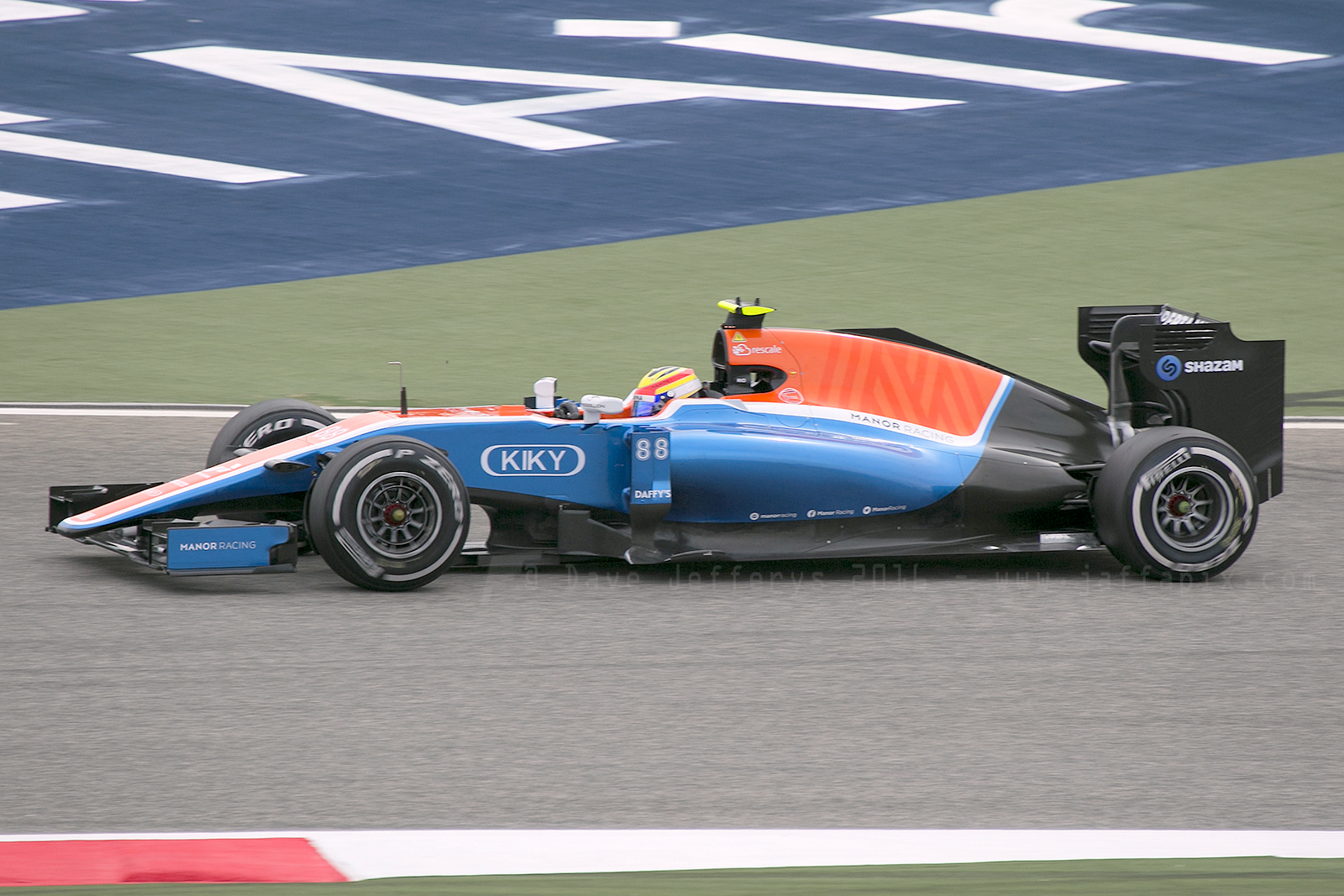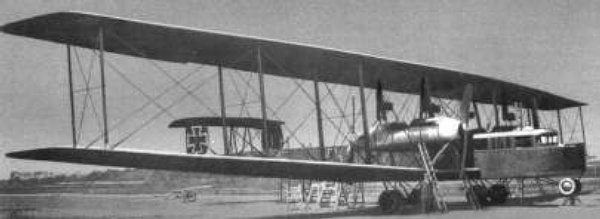|
DFW R.II
The DFW R.II (company designation T26 II) was a heavy bomber () aircraft designed by the (DFW) during the First World War for the Imperial German Army's () Imperial German Air Service (). Six aircraft were ordered in late 1916; of these three were completed, two were unfinished when the war ended in November 1918 and the last was cancelled. None of the aircraft flew any combat missions. Design and development The Imperial German Air Service wanted an improved version of the R.I with a greater payload. The same arrangement of four inline engines mounted in the fuselage, driving two tractor propellers and two pusher propellers via long driveshafts was used. Having learned from the experiences with the R.I, the engine mounts of the R.II were built from pressed steel integrated with the fuselage frames. The shorter crankshafts of the Mercedes D.IVa straight-six piston engines in the R.II did not cause any new problems, but the aircraft still had vibration problems. These were t ... [...More Info...] [...Related Items...] OR: [Wikipedia] [Google] [Baidu] |
WikiProject Aircraft
A WikiProject, or Wikiproject, is an affinity group for contributors with shared goals within the Wikimedia movement. WikiProjects are prevalent within the largest wiki, Wikipedia, and exist to varying degrees within Wikimedia project, sibling projects such as Wiktionary, Wikiquote, Wikidata, and Wikisource. They also exist in different languages, and translation of articles is a form of their collaboration. During the COVID-19 pandemic, CBS News noted the role of Wikipedia's WikiProject Medicine in maintaining the accuracy of articles related to the disease. Another WikiProject that has drawn attention is WikiProject Women Scientists, which was profiled by ''Smithsonian Magazine, Smithsonian'' for its efforts to improve coverage of women scientists which the profile noted had "helped increase the number of female scientists on Wikipedia from around 1,600 to over 5,000". On Wikipedia Some Wikipedia WikiProjects are substantial enough to engage in cooperative activities with outsi ... [...More Info...] [...Related Items...] OR: [Wikipedia] [Google] [Baidu] |
Straight-six Engine
A straight-six engine (also referred to as an inline-six engine; abbreviated I6 or L6) is a piston engine with six cylinders arranged in a straight line along the crankshaft. A straight-six engine has perfect primary and secondary engine balance, resulting in fewer vibrations than other designs of six or fewer cylinders. Until the mid-20th century, the straight-six layout was the most common design for engines with six cylinders. However, V6 engines gradually became more common in the 1970s and by the 2000s, V6 engines had replaced straight-six engines in most light automotive applications. Characteristics In terms of packaging, straight-six engines are almost always narrower than a V6 engine or V8 engine, but longer than straight-four engines, V6s, and most V8s. Compared to V-configuration engines with similar power and displacement, the straight configuration has fewer injectors, a single head, and a single exhaust manifold, all contributing to better reliability and perfor ... [...More Info...] [...Related Items...] OR: [Wikipedia] [Google] [Baidu] |
Mid-engined Aircraft
In automotive engineering, a mid-engine layout describes the placement of an automobile engine in front of the rear-wheel axles, but behind the front axle. History The mid-engine, rear-wheel-drive format can be considered the original layout of automobiles. A 1901 Autocar was the first gasoline-powered automobile to use a drive shaft and placed the engine under the seat. This pioneering vehicle is now in the collection of the Smithsonian Institution. Benefits Mounting the engine in the middle instead of the front of the vehicle puts more weight over the rear tires, so they have more traction and provide more assistance to the front tires in braking the vehicle, with less chance of rear-wheel lockup and less chance of a skid or spin out. If the mid-engine vehicle is also rear-drive the added weight on the rear tires can also improve acceleration on slippery surfaces, providing much of the benefit of all-wheel-drive without the added weight and expense of all-wheel-drive comp ... [...More Info...] [...Related Items...] OR: [Wikipedia] [Google] [Baidu] |
1910s German Bomber Aircraft
Year 191 ( CXCI) was a common year starting on Friday of the Julian calendar. At the time, it was known as the Year of the Consulship of Apronianus and Bradua (or, less frequently, year 944 ''Ab urbe condita''). The denomination 191 for this year has been used since the early medieval period, when the Anno Domini calendar era became the prevalent method in Europe for naming years. Events By place Parthia * King Vologases IV of Parthia dies after a 44-year reign, and is succeeded by his son Vologases V. China * A coalition of Chinese warlords from the east of Hangu Pass launches a punitive campaign against the warlord Dong Zhuo, who seized control of the central government in 189, and held the figurehead Emperor Xian hostage. After suffering some defeats against the coalition forces, Dong Zhuo forcefully relocates the imperial capital from Luoyang to Chang'an. Before leaving, Dong Zhuo orders his troops to loot the tombs of the Han emperors, and then destroy Luoyang ... [...More Info...] [...Related Items...] OR: [Wikipedia] [Google] [Baidu] |
DFW Aircraft
DFW may refer to: Businesses *, an early twentieth century German aircraft manufacturer *Dutch FilmWorks, a film distributor *Duty Free World, a US-based in-flight shopping company Government agencies *Division of Fisheries and Wildlife (Massachusetts) *Kentucky Department of Fish and Wildlife Resources *Oregon Department of Fish and Wildlife Other uses *Dallas–Fort Worth metroplex, in north Texas, United States **Dallas Fort Worth International Airport, IATA airport code and FAA location identifier *David Foster Wallace (1962–2008), American novelist *Dhaka Fashion Week, a clothing festival in Bangladesh *Diffusion welding * Cosworth DFW, an automobile racing engine * "DFW" (''Brooklyn Nine-Nine''), a television episode *Deborah Frances-White Deborah Frances-White (born 10 December 1967) is a London-based comedian, author and screenwriter. She has both British and Australian citizenship. She hosts the podcasts ''Global Pillage'' and '' The Guilty Feminist''. She wrot ... [...More Info...] [...Related Items...] OR: [Wikipedia] [Google] [Baidu] |
List Of World War I Central Powers Aircraft
This is a list of military aircraft used by the Central Powers in World War I Austro-Hungarian aircraft Built specifically for or in Austria-Hungary, whose designation system was based on the German one, but with duplications for unrelated designs. German designs used by Austria-Hungary and Germany are in German section. A & B types (unarmed monoplanes and biplanes) * Aviatik B.III (1916) * Etrich Taube (1911) * Fokker B.I (1915)Gray, 1970, p.339 * Fokker B.II (1916) * Fokker B.III – reconnaissance/fighter * Hansa-Brandenburg B.I (1914) * Lohner B.I (1912) * Lohner B.II (1913) * Lohner B.III * Lohner B.IV * Lohner B.V * Lohner B.VI * Lohner B.VII (1915) C types (armed two seat biplanes) * Aviatik (Ö) C.I (1916) * Hansa-Brandenburg C.I * Knoller C.I (1916) * Knoller C.II (1916) * Lloyd C.I (1914) * Lloyd C.II (1915) * Lloyd C.III * Lloyd C.IV * Lloyd C.V (1917) * Lohner C.I (1916) * Phonix C.I (1918) D types (''Doppeldecker'' – armed single seaters) * ... [...More Info...] [...Related Items...] OR: [Wikipedia] [Google] [Baidu] |
Bristol Braemar
The Bristol Braemar was a British heavy bomber aircraft developed at the end of the World War I, First World War for the Royal Air Force. Only two prototypes were constructed. Development The prototype Braemar was developed in response to the establishment of the Independent Air Force in October 1917, as a bomber capable of the long-range bombing of Berlin if necessary. A large triplane, it had internal stowage for up to six 250 lb (110 kg) bombs. The initial design featured an unusual engine installation with a central engine room housing all four engines. These were to be geared in pairs and power taken from the engines to the four propellers by power shafts. This design was abandoned early in development, and both the completed Braemars had a conventional engine installation, with the engines in inline tandem pairs, driving Push-pull configuration, pusher and tractor propellers. However, the engine-room design was resurrected later in the Braemar's development life, ... [...More Info...] [...Related Items...] OR: [Wikipedia] [Google] [Baidu] |
Water-cooled
Cooling tower and water discharge of a nuclear power plant Water cooling is a method of heat removal from components and industrial equipment. Evaporative cooling using water is often more efficient than air cooling. Water is inexpensive and non-toxic; however, it can contain impurities and cause corrosion. Water cooling is commonly used for cooling automobile internal combustion engines and power stations. Water coolers utilising convective heat transfer are used inside high-end personal computers to lower the temperature of CPUs and other components. Other uses include the cooling of lubricant oil in pumps; for cooling purposes in heat exchangers; for cooling buildings in HVAC and in chillers. Mechanism Advantages Water is inexpensive, non-toxic, and available over most of the earth's surface. Liquid cooling offers higher thermal conductivity than air cooling. Water has unusually high specific heat capacity among commonly available liquids at room temperature and atmosph ... [...More Info...] [...Related Items...] OR: [Wikipedia] [Google] [Baidu] |
Airliner
An airliner is a type of airplane for transporting passengers and air cargo. Such aircraft are most often operated by airlines. The modern and most common variant of the airliner is a long, tube shaped, and jet powered aircraft. The largest of them are wide-body jets which are also called twin-aisle because they generally have two separate aisles running from the front to the back of the passenger cabin. These are usually used for long-haul flights between airline hubs and major cities. A smaller, more common class of airliners is the narrow-body or single-aisle. These are generally used for short to medium-distance flights with fewer passengers than their wide-body counterparts. Regional airliners typically seat fewer than 100 passengers and may be powered by turbofans or turboprops. These airliners are the non- mainline counterparts to the larger aircraft operated by the major carriers, legacy carriers, and flag carriers, and are used to feed traffic into the large a ... [...More Info...] [...Related Items...] OR: [Wikipedia] [Google] [Baidu] |
Zeppelin-Staaken R
Zeppelin-Staaken (sometimes ), was a German aircraft manufacturer originally named (Experimental Works Gotha-East (V.G.O.)) when it was formed in mid-1914 by Count Ferdinand von Zeppelin and Robert Bosch. The company rented facilities in Gotha with the objective to build large, long-range bomber aircraft. Alexander Baumann was hired by Zeppelin as the head designer. The company moved to the village of Staaken, near Berlin, in mid-1916 and was renamed , although it was commonly known as Zeppelin-Staaken.Haddow & Grosz, pp. 209–211, 230–231 Aircraft built * Zeppelin-Staaken L * Zeppelin-Staaken VGO.I * Zeppelin-Staaken VGO.II * Zeppelin-Staaken VGO.III * Zeppelin-Staaken R.IV * Zeppelin-Staaken R.V * Zeppelin-Staaken R.VI * Zeppelin-Staaken R.VII * Zeppelin-Staaken 8301 * Zeppelin-Staaken R.XIV * Zeppelin-Staaken R.XV * Zeppelin-Staaken R.XVI *Zeppelin-Staaken E-4/20 The Zeppelin-Staaken E-4/20 was a revolutionary four-engine all-metal passenger monoplane designed in 1 ... [...More Info...] [...Related Items...] OR: [Wikipedia] [Google] [Baidu] |




